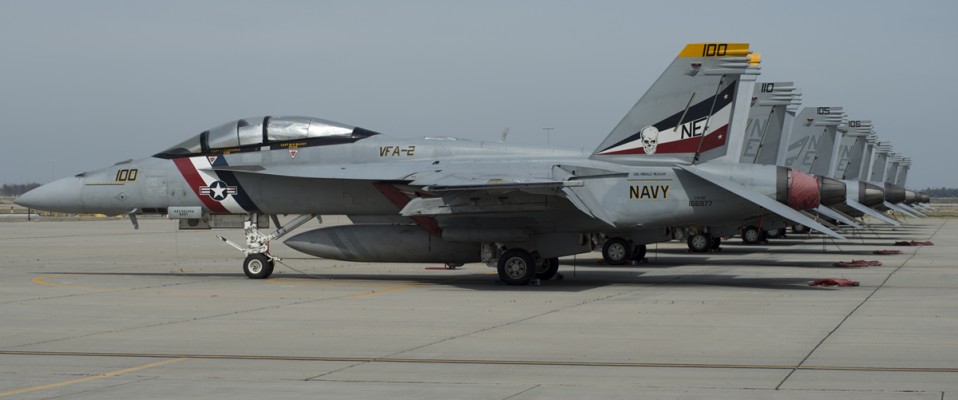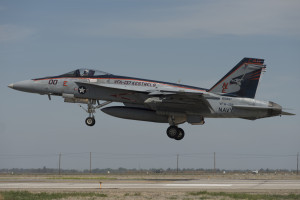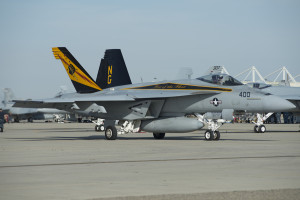Lemoore prepares for Lightning Strike!
Located west of Visalia, California and north of Bakersfield, Naval Air Station Lemoore is the west-coast Master Jet Base of the U.S. Navy. Home to four Carrier Air Wings, Carrier Air Wing Two (CVW-2), Carrier Air Wing Nine (CVW-9), Carrier Air Wing Eleven (CVW-11), and Carrier Air Wing Seventeen (CVW-17), NAS Lemoore hosts the Navy’s entire west coast fighter/attack fleet.
In October 2014, the U.S. Navy announced its decision to base the Lockheed Martin F-35C at Lemoore with an expectation of 100 F-35C aircraft replacing 70 F/A-18 Hornets.
Patrick Roegies, Paul Gross and Hans Looijmans visited NAS Lemoore and report on the transition to the F-35.
Article and Photos by Patrick Roegies, Paul Gross and Hans Looijmans
Introduction
Currently the Navy has stationed its F/A-18 Hornet fleet at two Strike Fighter Super Hornet/Hornet bases. NAS Oceana on the East Coast and NAS Lemoore on the West Coast.
As of 2012, the mid-term plan included the relocation of two East Coast squadrons to the West Coast. This relocation was deemed necessary in order to provide the strike fighter community fighter squadrons to meet the changing operational demand in the Pacific. It also enables the Navy to mitigate a possible shortage in strike fighter community assets due to the aging FA-18 “Legacy Hornet” aircraft. Conversion of up to an additional five Strike Fighter squadrons from “Legacy Hornet” to “Super Hornet” squadrons should result in the alignment of Strike Fighter community assets to meet carrier air wing deployment schedules, and to ensure sufficient Strike Fighter capability is present in the short term.
Current conversion to Super Hornet
The conversion of F/A-18 squadrons at NAS Lemoore to Super Hornet squadrons is in full progress. In 2014, both VFA-97 “ Warhawks” and VFA-192 “Golden Dragons” were in the process of conversion. VFA-97’s conversion to Super Hornets commenced in December 2013. The last “Warhawk” Legacy Hornets left NAS Lemoore in November 2013 and the first Super Hornets arrived at the squadron on December 2nd 2013. VFA-97 took delivery of brand new factory delivered F/A-18E’s. Carrier deck qualifications took place in February 2014 on the USS George Bush and were completed successfully.
VFA-192 received their first Super Hornets by the end of 2013 but in contrast to VFA-97 they did not receive factory new F/A-18E’s. Instead of receiving brand new factory Hornets the squadron received Lot 23/24 FA-18E Super Hornets which were acquired from VFA-27. Since these Hornets were already appointed to VFA-27 and had already seen considerable action before they were transferred to VFA-192, each aircraft that was received was subjected to thorough maintenance, in practice meaning that the entire airframe was stripped and inspected.
The two remaining squadrons at NAS Lemoore operating the Legacy Hornets are VFA-94 and VFA-113. They are currently in the process of converting to the Super Hornet.
For newly winged aviators from the training commands, their next assignment before arriving at an operational squadron is to go to a Fleet Replacement Squadron (FRS) formerly known as and still usually referred to as the RAG squadron (The FRS’s were formerly known as Replacement Air Groups, and are thus commonly called “Rags”).
The appointed FRS squadron at Lemoore is VFA-122. At VFA-122 the fresh aviators will go through an entire syllabus to learn the basics of operating and tactically employing the Hornet or Rhino before they are assigned to an operational squadron. New aviators at the FRS will go through a series of familiarization simulators before their first flight in the F-18. The first few flights are dualed up in a trainer aircraft, but the first solo comes much earlier than in the T-34, T-6 or T-45 syllabus. After that point the ‘Cones’ as the trainees are affectionately referred to will progress through the syllabus and perform various air-to-surface and air-to-air flights, some of which will be conducted as solo aircrew and some with an instructor in the back seat. The RAG students are referred to as “Cones” because new F-18 pilots are considered “Category One” (Cat One – C. One – “Cone”) students. There are 4 categories. Cat 1 is brand new students flying the F-18. Cat 2 would be for pilots with tactical jet experience, but transitioning into the F-18 (like the Tomcat, S-3, etc). Cat 3 and 4 are for F-18 pilots that have been out of the cockpit for a certain amount of time.
The operational squadrons are responsible for training up their new aircrew to become section and division flight leads. The weapons school at NAS Fallon mostly trains candidates going through the TOP GUN course or provides training to air wings while they’re working up for their deployments at NAS Fallon.
Preparing for the Lightning Strike!
The Navy’s conversion to the F-35C Lightning II is currently in the early stages.
Coupled with the US military realignment strategy, NAS Lemoore is to become the largest fighter hub in the US Navy. The plan comprises the relocation of two East Coast Super Hornet squadrons to geographically align and equally divide the strike fighter squadrons with the current Carrier Air Wing deployment requirements. In the current situation, two East Coast squadrons are the subject of multiple cross continental transits to train and certify with the aircraft carrier and Carrier Strike Group. Relocating the East Coast Strike Fighter Squadrons to NAS Lemoore would provide necessary support without duplication of existing home base support functions and would realign the Fleet with East/West operational commitments.
The proposed action would relocate two East Coast FA-18E/F Super Hornet squadrons to NAS Lemoore. The two squadrons that are nominated to be relocated to NAS Lemoore are VFA-11 and VFA-136. Specifically, the proposed Strike Fighter realignment would consist of the following primary actions which already commenced from 2013 forward:
- Two existing squadrons VFA-97 and VFA-151 completed their transition from 10-plane Hornet squadrons to 10-plane Super Hornet squadrons. The conversion commenced in 2013 and was completed by the end of the year.
- VFA-192 started their transition from a 10-plane Hornet squadron to a 10-plane Super Hornet squadron in 2014 is and was completed that same year.
- VFA-146 started their transition in January 2015 from a 10-plane Hornet squadron to a 12-plane Super Hornet squadron and has recently completed their conversion.
- The two remaining squadrons VFA-113 and VFA94 equipped with the F/A-18C are currently on a deployment on board the USS carl Vinson. Upon their return to NAS Lemoore the squadrons will start their transition to the Super Hornet. VFA-94 will acquire the old VFA-2 F/A-18F’s and VFA-113 will receive the F/A-18E. Depending on the return of these two squadrons the conversion process will be started and completed which is planned for 2015.
- Hangars 1, 2 and 4 were modified for the purpose to host the Super Hornets
- Hangars 5 and 6 will be modified to host the new F-35C aircraft
- As a separate action NAS Lemoore would reduce the number of training aircraft in its training squadron VFA-122 between 2012 and 2013 which is already completed.
- Both East Coast Super Hornet squadrons will arrive at NAS Lemoore by 2017. Strike Fighter Squadron VFA-136 will relocate as a 12-plane FA-18E squadron and Strike Fighter Squadron VFA-11 as a 12-plane F/A-18F squadron. One squadron is planned to be relocated in June 2016 and the other squadron is planned to relocate in January 2017.
The plans became more specific when the Navy announced that NAF El Centro will not be the host for the US Pacific Fleet F-35C aircraft. In the previous years, several studies have been conducted to determine the possibilities, the necessary requirements and the consequences of converting NAF El Centro into a Homebase for the Pacific “Lightning” Strike force. Apparently these plans have been abandoned and NAS Lemoore was the remaining alternative to be the host. This means NAS Lemoore is planning for the arrival of the new aircraft, with conversion to Super Hornet still in progress.
The intended target is to transfer NAS Lemoore from a host of 15 F/A-18C, E and F squadrons into a base of 17 F-35C and F/A-18E/F squadrons between 2028 and 2030. The expected result will be a total of 7 F-35C squadrons, 6 F/A-18F squadrons and 4 F/A-18E squadrons. Each squadron will be equipped with 10 aircraft. When the plan is completed, NAS Lemoore will host 60% of the Navy strike fighter capacity within the Navy.
Fleet Replacement preparations
Strike Fighter Squadron VFA-101 is currently based at Eglin Air Force Base being the initial squadron equipped with the F-35C. Initially, VFA-101 was an F-14 RAG squadron and used to be based at NAS Oceana. When VFA-101 withdrew the F-14’s from use the squadron was appointed as the Fleet Replacement Squadron (FRS) for the F-35C. The squadron moved to Eglin AFB and is expected to move to its new Homebase NAS Lemoore in January 2017.
VFA-101 is currently in the process of gaining newly delivered aircraft, training instructor pilots and maintainers preparing for their new task at NAS Lemoore. One year after its arrival at NAS Lemoore the squadron will begin to transition fleet squadrons into the F-35C. The conversion process too is expected to take one year to accomplish initially and with more squadron shifts from the Hornet to the Lightning II the squadron hopes to be more efficient by gained experience and shorten the conversion time. It is intended that VFA-101 will be equipped with 30 aircraft in order to perform its training and conversion mission. If the plan is actually met depends on the pass of delivery of the new F-35C’s to the Navy.
The first squadron to transfer to the F-35C is VFA-97 “Warhawks” is planned for January 2018. This could change due to a number of factors such as changes in the deployment schedules and could have an impact on this decision.
The project officer on the staff of Strike Fighter Wing Pacific is Cmdr. Ryan “Spool” Douglas. Already Douglass and planners have started work on the relocation to NAS Lemoore. They will begin by reworking the existing hangar 5. Douglass has planned the military construction over the next 10 years constantly growing F-35 presence on the base. The new hangars will be constructed based on a module concept where each appointed squadron will have their own module intended for 4 squadrons host in the future. The design is currently completed and has been send out to contractor bids. The plan was to start reconstructions of the first module in July 2015. By the end of 2015, the remaining 3 modules are planned to be reconstructed which will take approximately 2 years to complete. Once completed VFA-101 and the first currently selected transition fleet squadron VFA-97 will take up residence in the hangar. In 2018, construction is planned to start on hangar 6, to be the host of the other selected F-35C squadrons.
Compared to an F/A-18 squadron, an F-35C squadron has an additional number of enlisted maintainers planned. Where an F/A-18E/F squadron counts between 226 and 234 FTE, an F-35C squadron is planned to require between 245 and 250 FTE. The main reason is the creation of an entirely new maintenance shop manned by aviation structural mechanics for each F-35C squadron and will be responsible for maintaining the outside of the aircraft. The used skin material of the F-35C has stealth capabilities and is designed to deflect radar. Since the importance of Stealth capability it is important that there will be a new maintenance shop in the squadron, manned by personnel with special training and skills.
Aviation Photography Digest plans to continue to provide you with updates on the F-35 Lightning II JSF program as it progresses. This includes our continued coverage of A, B and C variants flown by the U.S., partner and foreign military sales (FMS) nations.
You can stay up to date by subscribing to our FREE newsletter updates, or by following us on Facebook or Twitter.








